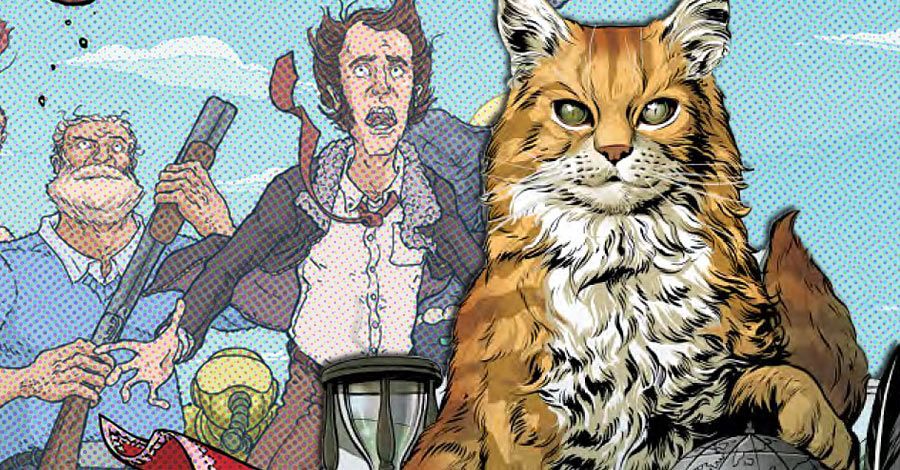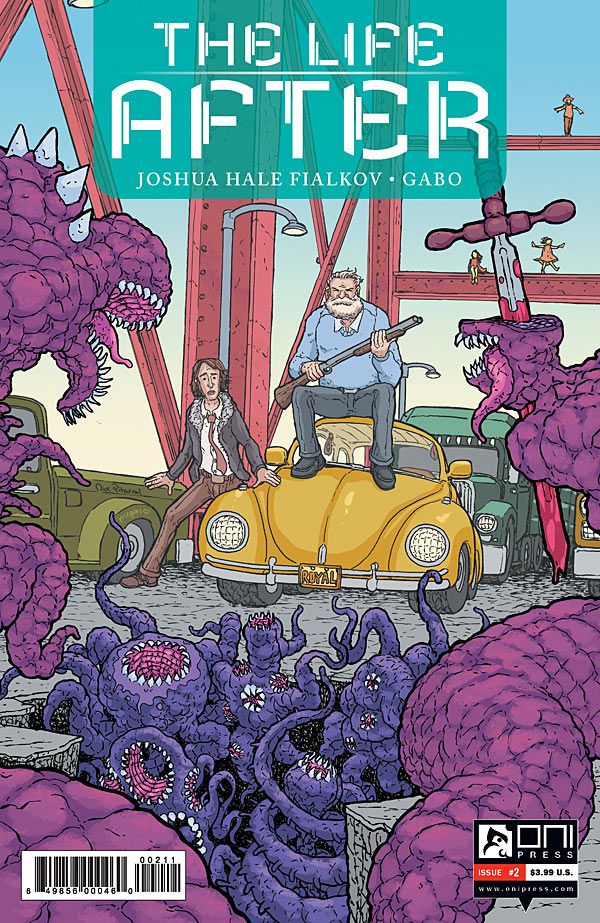Oni Press director of publicity John Schork led a humorous and engaging panel focused on two of the publisher's most lauded new properties, "I Was the Cat" and "The Life After."
The panel began with artist Benjamin Dewey and writer Paul Tobin discussed their original graphic novel, "I Was The Cat." But before they were willing to discuss their own work, they liberally ribbed their co-panelists, writer Joshua Hale Fialkov and artist Gabo about the arduous fifty-panel two-page spread from the debut issue of "The Life After."
Dewey and Tobin brought a set of flowcharts to explain the labyrinthine happenings in the story, which they likened to a choose your own adventure story, something Tobin considered unusual. "It was nuts," Tobin said. "You go through the door to the right or the left. Uh, I go left, okay the monster chops your head off. Well, I go right, then fall into the death trap. They were like three pages long. You should have called them 'Choose Your Own Death Quickly.'"
The cover was meant to hearken back to the famous photo of Teddy Roosevelt standing next to a globe in a clear illustration of power. "On the cover I tried to put in a lot of things that would hint at this larger story. do the same thing with this cat, put things that would hint at his power, like a cell phone and bullets and an apple. Everyone needs an apple if they wanna be in charge. That's the way it goes. Things that indicate the amount of time he's been alive and interacting with the world."
SDCC: Spotlight on Colleen Coover & Paul Tobin
Tobin then explained the story's central conceit. "I had noticed that a lot of the old megalomaniacal people in cartoons, they would always have a cat, not only modern media, even in paintings of the past. What if that cat had always been the same cat, using previous lives, to try to take over the world?" Tobin mused. "What if that cat in the lap was actually the one in charge? The story of 'I Was The Cat,' Burma, the main cat there, is telling his memoirs to Jo. He's posing it as a simple 'I just want a memory of my life,' but she's slowly learning he's on his final life, and he's pretty damned busy with that final life, he's not done with his world plans yet."
Both Tobin and Dewey were huge history buffs and dived into the research for this project with great vigor. Tobin said "I would be researching what would some guy in 1722 be wearing to a ball, or when he was digging a ditch. It became this obsessive thing."
"You wanna get a sense of what regular people are wearing, then you have to get etchings from a 'Canterbury Tales' or something," Dewey added. "The script was chock full of all these details, I tried to be true to it."
Dewey said that he tried to make many of the settings have a character of their own, noting that he included many extraordinarily expensive paintings, such as Rembrandts, in the background to show the personality of the lead character. Dewey's father worked in a museum, and the artist used many things he remembered from his childhood to influence
The lights dimmed for a moment as the event staff tried to make it easier for attendees to see the screen, then came up just as quickly. Fialkov expressed disappointment, saying, "We were starting to make out a little over here."
Next the presentation walked through a scene in the book where the interviewer is introduced to the protagonist by a butler in an expansive, opulent mansion.
"This is based on the house that Ben wants and expects from the Oni proceeds," Tobin joked. They noted that they tried to work the huge globe into as many images as possible, and then pointed out that among the many treasures the cat held was a samurai's gear and a space suit from Apollo 11.
"If I was a world-dominating cat," Dewey said, "I would want the Apollo 11 space suit!"
Tobin replied, "If you were Ben Dewey, I think you'd want that. You pretty much win the cosplay event with that."
Dewey noted that Burma is based on his fifteen-pound cat who is "very withholding with her love."
CBR TV: Fialkov on "The Life After," Personal Struggles & Finding Happiness">
Dewey discussed the logistical challenge of getting word balloons to work for characters with such drastically different heights and the challenges in a consistent coloring pattern for a certain kind of feline. Dewey also used different color palettes -- golds for ancient Egypt, royal blues for France, et cetera -- to differentiate the time periods from flashbacks.
In a scene depicting a feline takeover of the future, there's a reference to the Dutch artist who turned his dead cat into a flying drone and fans can download a printable version of the cat glider from the Oni Press' website, which Dewey designed to make sure it would loop right back to the user.
"Put your own eye out," Tobin suggested, which Dewey found correct.
Next, Schork joined Fialkov and Gabo in a live reading of the second issue of "The Life After," which opened up considerable spoilers for those in attendance. Nonetheless, the publisher provided a number of pages to help showcase the issue.
After the dramatic presentation, the floor was opened to questions. Dewey and Tobin were asked how much of the intricate detail in the project was done by each creator, by percentage. Dewey responded, "50/50," while Tobin said, "I was waiting to see what he said, in case he said 70/30!" Dewey noted that for many moments in the script for "I Was the Cat, Tobin put notes in such as, "make sure you look at pictures of London."
Tobin noted his pleasure with Dewey after having some bad experiences, citing a particular "Wolverine" issue where the title character was supposed to emerge from a bunker and be surrounded by hordes of ninjas. The artist drew no ninjas, so the script had to be changed to have Logan saying, "I smell 'em."
"Backgrounds are like a character in the story," Dewey said. "It has an impact over the rest of the events that transpire. I really try to adhere to the script."
Tobin once again talked about the 50-panel spread from "The Life After" #1, complimenting it, but began to digress, saying, "I write at a cafe and get this sandwich called a Hemingway, and it's made of..."
"Buckshot?" Schork asked.
Tobin ignored that and talked at length about how he related to the tedium of the sequence, and Gabo finally added, "I love that we've talked about a two-page spread for like twenty minutes. When you get to it, you'll be like, 'that's it?'"
When looking at the underlying themes of "The Life After," Fialkov said, "The idea is that religion is about being nice. What happens is that there's all these laws and rules piled up on top of them, and that's where the fighting comes. They start arguing about the semantics and that leads to the bloodiest wars, to quote 'Hitchhiker's Guide.' It's a taboo subject, and people who commit suicide, they don't do it lightly. They can't cope. The idea of there being a loving god who says, 'Fuck those people,' that just kills me."
RELATED: The Dogmatic Exploration of Fialkov's "The Life After"
Fialkov talked about the religious basis of this purgatorical system, saying that the guys who are running things are just the current management. "That system worked great until it broke down and they replaced it," Fialkov said, much like the Veterans Administration systems using computer systems from the early 1980s. "Makes us look at what's really a sin," Fialkov continued. "Like loving people, is that really a sin? As a Jew, raised as a Jew, even the pork thing, the reason we don't eat pork is that before people cured meat properly, people would get shigellosis, because pigs live in shit. Does that mean we still can't have an Egg McMuffin? I can't believe in a god that wouldn't let me have an Egg Mcmuffin. If you're okay eating pork with the poop baked in, that's fine."
Dewey and Tobin said they have no plans for a sequel, although the idea of other multi-lived megalomaniacal cats was something they had considered.
Somehow, this led to a discussion of Morrissey, to which Dewey replied, "The first time I heard Morrissey, I though it was a Muppets record."
Tobin considered that. "It sounded a lot like Kermit having a really hard time."
"I haven't started a second one, I'm happy with the ending," Tobin said, bringing things back to the topic at hand. "Sometimes moving on to the next idea is more fun than saying, 'how can I have this happen in a different way. I can't say there won't be any plans."
A fan asked about the cat's last life expiring if suicide was possible, leading to a crossover.
"While all dogs go to heaven, all cats go to hell," Fialkov said, which ended the panel with a laugh.


